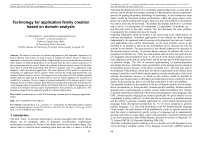Technology for application family creation based on domain analysis
Автор: Gudoshnikova A.A., Litvinov Y.V.
Журнал: Труды Института системного программирования РАН @trudy-isp-ran
Статья в выпуске: 2 т.28, 2016 года.
Бесплатный доступ
The theme of code reuse in software development is still important. Sometimes it is hard to find out what exactly we need to reuse in isolation of context. However, there is an opportunity to narrow the context problem, if applications in one given domain are considered. Same features in different applications in one domain have the same context respectively so the common part must be reused. Hence, the problem of domain analysis arises. On the other hand, there is metaCASE-techonology that allows to generate code of an application using diagrams, which describe this application. The main objective of this article is to present the technology for application family creation which connects the metaCASE-techonology and results of domain analysis activity. We propose to use some ideas of FODA (feature-oriented domain analysis) approach for domain analysis and use feature diagrams for describing of variability in a domain. Then we suggest to generate metamodel of the domain-specific visual language, based on feature diagram. After that based on generated metamodel domain-specific visual language editor is generated with the aid of metaCASE-tool. With this language user can connect and configure existing feature implementations thus producing an application. This technology supposed to be especially useful for software product lines.
Domain analysis, metacasetechnology, domain-specific language, application family, metacase-технология
Короткий адрес: https://sciup.org/14916349
IDR: 14916349 | DOI: 10.15514/ISPRAS-2016-28(2)-6
Список литературы Technology for application family creation based on domain analysis
- Tolvanen J.-P., Kelly S.Model-Driven Development Challenges and Solutions//Modelsward 2016. 2016. P. 711-719.
- Baker P., Loh S., Weil F. Model-driven engineering in a large industrial context -Motorola case study//MoDELS'05: Proceedings of the 8th international conference on Model Driven Engineering Languages and Systems. Berlin: Springer, 2005. P. 476-491.
- A software engineering experiment in software component generation/R. Kieburtz, L. McKinney, J. Bell et al.//Proceedings of the 18th international conference on Software engineering. Washington, DC, USA: IEEE Computer Society, 1996. P. 542-552.
- Kelly S., Tolvanen J.-P. Visual domain-specific modeling: Benefits and experiences of using metaCASE tools//International Workshop on Model Engineering, at ECOOP. 2000. URL: http://dsmforum.org/papers/Visual_domain-specific_modelling.pdf.
- Tolvanen J.-P., Pohjonen R., Kelly S. Advanced tooling for domain-specific modeling: MetaEdit+//Proceedings of the 7th OOPSLA Workshop on Domain-Specific Modeling (DSM'07). 2007. URL:http://www.dsmforum.org/events/DSM07/papers/tolvanen.pdf.
- Tolvanen J.-P.and Kelly S. MetaEdit+: defining and using integrated domain-specific modeling languages//Proceedings of the 24th ACM SIGPLAN conference companion on Object oriented programming systems languages and applications/ACM. New York, NY, USA: ACM, 2009. P. 819-820.
- Kelly S., Tolvanen J.-P. Domain-specific modeling: enabling full code generation. Hoboken, New Jersey, USA: Wiley-IEEE Computer Society Press, 2008. P. 444.
- Gronback R. Eclipse Modeling Project: A Domain-Specific Language (DSL) Toolkit. Stoughton, Massachusetts, USA: Addison-Wesley, 2009. P. 736.
- Viyovic V., Maksimovic M., Perisic B. Sirius: A rapid development of DSM graphical editor//IEEE 18th International Conference on Intelligent Engineering Systems INES 2014. Los Alamitos, CA, USA: IEEE Computer Society, 2014. P. 233-238.
- Domain-specific development with Visual Studio DSL Tools/S. Cook, G. Jones, S. Kent et al. Crawfordsville, Indiana, USA: Addison-Wesley, 2007. P. 576.
- Koznov D. Process Model of DSM Solution Development and Evolution for Small and Medium-Sized Software Companies//Enterprise Distributed Object Computing Conference Workshops (EDOCW), 2011 15th IEEE International/IEEE. 2011. P. 85-92.
- QReal DSM platform-An Environment for Creation of Specific Visual IDEs/A. Kuzenkova, A. Deripaska, T. Bryksin et al.//ENASE 2013-Proceedings of the 8th International Conference on Evaluation of Novel Approaches to Software Engineering. Setubal, Portugal: SciTePress, 2013. P. 205-211.
- Rugaber S. Domain analysis and reverse engineering//White Paper, January. 1994.
- Prieto-Diaz R. Domain analysis for reusability//Software reuse: emerging technology/IEEE Computer Society Press. 1988. P. 347-353.
- Ferre X., Vegas S. An evaluation of domain analysis methods//4th CASE/IFIP8 International Workshop in Evaluation of Modeling in System Analysis and Design/Citeseer. 1999. P. 2-6.
- Mernik M., Heering J., Sloane A. M. When and how to develop domain-specific languages//ACM computing surveys (CSUR). 2005. Vol. 37, no. 4. P. 316-344.
- Arango G. Domain analysis methods//Software Reusability. 1994. P. 17-49.
- DARE: Domain analysis and reuse environment/W. Frakes, R. Prieto, C. Fox et al.//Annals of Software Engineering. 1998. Vol. 5, no. 1. P. 125-141.
- Taylor R. N., Tracz W., Coglianese L. Software development using domain-specific software architectures//ACM SIGSOFT Software Engineering Notes. 1995. Vol. 20, no. 5. P. 27-38.
- Falbo R. D. A., Guizzardi G., Duarte K. C. An ontological approach to domain engineering//Proceedings of the 14th international conference on Software engineering and knowledge engineering/ACM. 2002. P. 351-358.
- Feature-oriented domain analysis (FODA): Tech. Rep.:/K. C. Kang, S. G. Cohen, J. A. Hess et al.: DTIC Document, 1990.
- Estublier J., Vega G. Reuse and variability in large software applications//ACM SIGSOFT Software Engineering Notes. 2005. Vol. 30, no. 5. P. 316-325.
- An approach and framework for extensible process support system/J. Estublier, J. Villalobos, L. Anh-Tuyet et al.//Software Process Technology. Springer, 2003. P. 46-61.
- The Variability Model of The Linux Kernel/S. She, R. Lotufo, T. Berger et al.//VaMoS. 2010. Vol. 10. P. 45-51.


